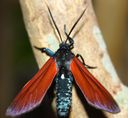Empyreuma
Empyreuma
Classification
- Phylum: Arthropoda
- Subphylum: Hexapoda
- Class: Insecta
- Order: Lepidoptera
- Superfamily: Noctuoidea
- Family: Erebidae
- Subfamily: Arctiinae
- Tribe: Arctiini
- Subtribe: Euchromiina
- Genus: Empyreuma
Pronunciation
How to pronounce Empyreuma: /ɛmˈpaɪˌruːmə/
These audio files are automatically generated. While they are not always 100% accurate, they are a good starting point.
Images





Summary
Empyreuma is a genus of tiger moths within the family Erebidae, renowned for their striking colorations and patterns. The genus includes the spotted oleander caterpillar moth, which has ecological significance as both a pollinator and a prey item in its habitat.
Physical Characteristics
Empyreuma species are characterized by their vibrant coloration typical of tiger moths, with patterns that help in camouflage against predators. The adult moths display a range of color variations, often featuring large spots or stripes.
Identification Tips
The most notable feature for identification is the presence of bright warning coloration and distinctive marking patterns on their forewings. The spotted oleander caterpillar moth (Empyreuma pugione) can be recognized by its unique spotted pattern.
Habitat
Empyreuma species are typically found in various habitats ranging from gardens and shrublands to more natural areas like forests, primarily in warmer regions.
Distribution
Primarily distributed across North America, with Empyreuma anassa, Empyreuma heros, and Empyreuma pugione found in specific locales.
Diet
The larvae of Empyreuma species, particularly the spotted oleander caterpillar moth, are known to feed on plants in the oleander family, while adult moths primarily consume nectar from flowers.
Life Cycle
Empyreuma undergoes a complete metamorphosis, including egg, larval (caterpillar), pupal (chrysalis), and adult stages.
Reproduction
Reproduction typically occurs through mating during the warmer months, followed by the females laying eggs on host plants suitable for their larvae.
Predators
Predators of Empyreuma moths include birds and other insectivorous animals, as their bright colors serve as a warning of potential toxicity.
Ecosystem Role
As pollinators, adult Empyreuma contribute to the ecosystem's floral diversity while the larvae may affect host plant populations.
Cultural Significance
The name 'Empyreuma' connects to the concept of heat and energy (live coal), reflecting the warning coloration and possibly serving as a metaphor in cultural discussions about fire and safety.
Collecting Methods
- Light trapping during night-time, attracting moths with ultraviolet lights.
- Manual collection from host plants and gardens.
Preservation Methods
- Pinning specimens through the thorax for long-term display.
- Storing in alcohol for genetic studies.
Misconceptions
Some may confuse Empyreuma moths with less palatable species due to their coloration, not recognizing their warning signals against predation.
Tags
- empireuma
- tiger moths
- Erebidae
- spotted oleander caterpillar moth
- North America